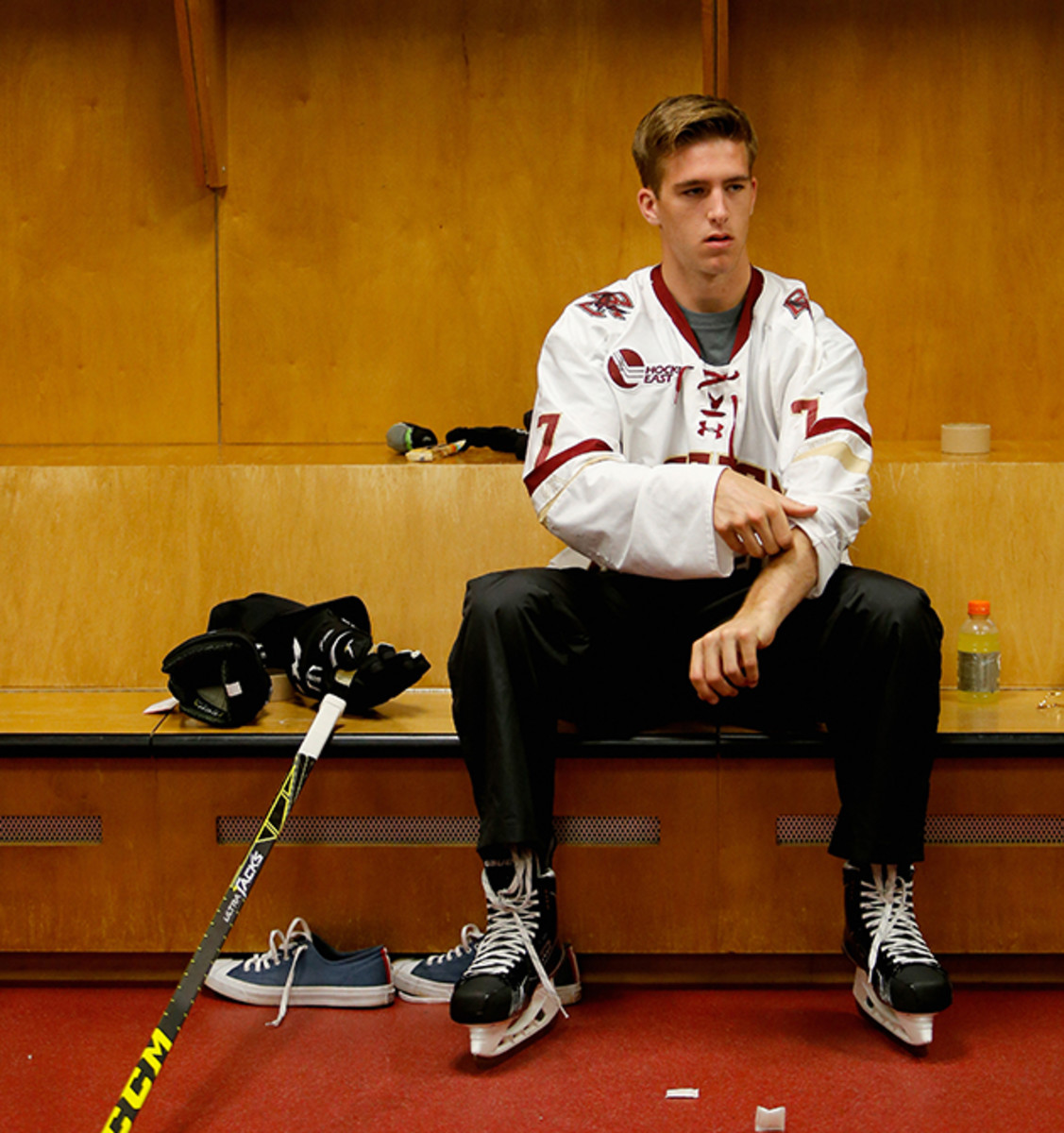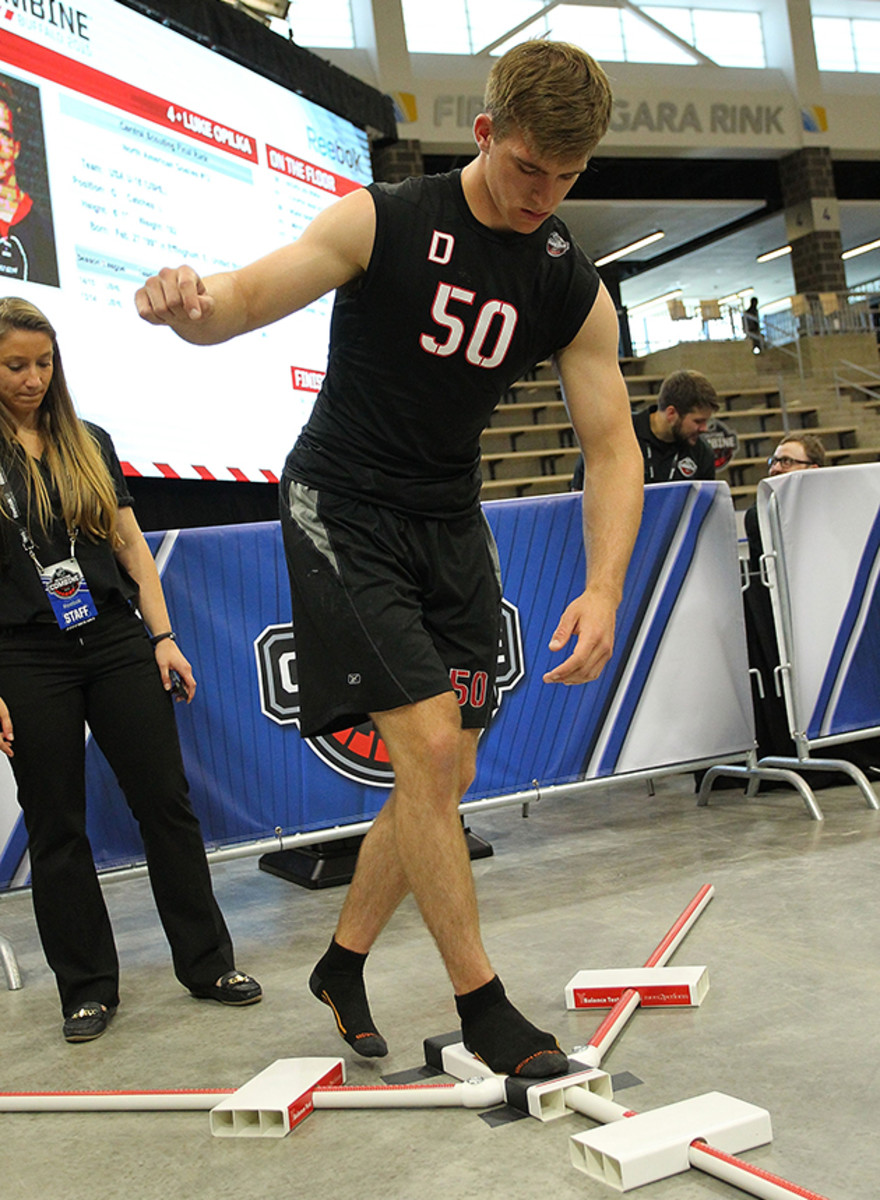Preparing mind and body for the NHL with top draft prospect Noah Hanifin

CHESTNUT HILL, Mass.—It’s one thing to play a sport. It’s another to love a sport. But the true test of character lies within the ability to dedicate mind, body and soul toward a discipline that will change one’s persona. Forever.
For Boston College’s Noah Hanifin, who’s the number one ranked defenseman—third prospect overall among North American skaters—in tonight’s NHL Draft, his bodily fitness hasn’t simply been just a hobby. It’s become a way of life.
“For me, I’m growing up in an age where strength and conditioning is very necessary,” says Hanifin, who became only the second youngest freshman in Boston College history to sport an Eagles’ hockey jersey. “My working out and physical strength has always been very important to me—that’s the only way I can use my skill and hockey ability.”
During this month’s NHL Scouting Combine in Buffalo, N.Y., which included strenuous fitness components, Hanifin executed his solid conditioning and finished in the top 10 in four tests. Hanifin’s biggest combine challenge—the infamous VO2max bike.
“You’re wearing an oxygen mask, so you get limited oxygen,” explains Hanifin, who also captained Team USA to a gold medal at the 2014 World Under-17 Hockey Challenge. “As you get more tired, you take deeper breaths but you get the same amount of oxygen. [But] I did bike training that would pattern me up and get me ready for it.”
Minnesota Wild center Charlie Coyle attests to Hanifin’s fitness dedication. “I've been training with Noah for a few years now and he is a worker,” Coyle tells SI.com. “You can tell how his work ethic in the gym translates to the ice and vice versa. It doesn't surprise me, at all, how well he did at the combine and his overall fitness level. He's a special player and has a lot of talent, but he works for it—that combination is deadly.”

met with SI.com on the campus of Boston College—just hours before the Chicago Blackhawks captured the Stanley Cup—to discuss his health and fitness, and its importance toward his craft.
age | height | weight |
|---|---|---|
18 years old | 6'3" | 205 lbs. |
Body fat: 6.1%
Training grounds: Edge Performance Systems, Foxborough, Mass.
Typical offseason workout: Four days per week—Monday, Tuesday, Thursday and Friday.
“I get to the gym about 9:15 a.m., I’ll ride the bike for five minutes, foam roll and do a dynamic stretching with all the guys.”
“Then, we’ll go through a pre-workout where we get medicine balls, hockey sticks and bands, and do all activation [exercises]—warming up our hips and the muscles we’re going to be utilizing during the workouts; doing a lot of core and quick explosives just to get us warmed up. [There’s] a lot of agility, like hurdle jumps, to get our muscles activated before we get into a lift. That takes about 30 minutes.”
How top NHL draft prospect Jack Eichel is building a pro-ready body
“Following that, we’ll do three sets of mini-band exercises, putting mini-bands around our knees and doing side lunges. Then, we’ll use a medicine ball and do a hip toss or seesaws around our back, and hurdle hops.”
“[Next], we’ll go into a lift. Mondays and Thursday are predominantly upper body. Tuesdays and Fridays are more specifically lower body, but because we skate a lot we don’t want to kill our lower body. What we’re big into now is we use a lot of Keiser machines, which are all air [resistance]—a lot of Keiser squats, and when we do upper body there’s a lot of Keiser pulls and pushes. I’ve noticed a huge difference in making myself more explosive on the ice by using the Keiser machines. … When I do weights, I’m doing hang cleans, single-leg squats or dumbbell snatches.”
“After we do a lift, we’ll do conditioning—sled pushes, drags or bike sprints in 30-second intervals because that’s how long our [hockey] shifts are. We want to train our bodies to be in that optional condition for 25-30 seconds—it’s all sprinting in hockey.”
“[Subsequently], we’ll do a lot of stretching—we’re really big on mobility and being flexible.”
Typical in-season workout: “I like to stay very flexible and mobile. Obviously, you have to do some lifts to maintain your strength—benching, squats, band work for our shoulders and a lot of plyometric jumps to stay explosive. I like to do a lot of free-body lunges and stretching. [During the] season you kill your body on the ice, so when you’re working out it’s to maintain the strength you’ve gained during the summer.”
Unique exercises: Sled figure eights and single-leg hang cleans. “We’ll do sled pushes but in a big figure eight. That’s brutal. … [For single-leg hang cleans] we’ll use straps and basically go up with one leg, and put one leg back—five reps on each leg. I love it.”
One exercise most essential for on-ice performance: Hang cleans. “That’s been the number one thing where I’ve seen improvements in my explosiveness—that translates onto the ice so well.”
Age he began a training program and his motivation: “Right as I turned 14. When I was in the eighth grade at St. Sebastian’s, I played varsity, so I was playing against kids who were 17, 18, 19 years old and I was 13. So, the biggest issue was going to be my physical strength playing against kids who are a lot older than me. That’s when I met Brian [McDonough], the guy I train with now. From that point on, I became close with Brian and I’ve gotten stronger and stronger.”
Evolution of his body: “I’ve gotten a lot bigger—I’m getting older, taller and heavier. But at the same time, my trainer has always realized what age I was and he’s specifically trained me for what I need to be working on at that age. When I was 14, I wasn’t doing a lot of lifting—I was doing a lot of non-weight [exercises], mobility and core work, and getting used to my body. Now, I’m doing a lot more lifting and Olympic exercises to get more explosive—I’m at that age where I can definitely do that.”

. When I had that experience it really pushed me just by being around those guys and seeing how they workout. So, I think I’m ahead of the curve because of the experience I have training with pro athletes.”
Favorite workout music: “I love to listen to music when I workout, mainly rock and roll—AC/DC.”
Favorite leisure activity: Golf. “You want to basically be doing something every day. On the weekends you just don’t want to sit around and not do anything—that’s actually worse for your body. You want to stay active, whether it’s going for a light jog or walk. For me, I love to golf on the weekends because it keeps me real active.”
Thoughts on eating right in college: “It’s so hard, but for me it’s a routine, it’s a habit. I like to eat the same every single day because I’m big into having a routine and getting the same amount of calories. In college it’s tough, but it’s definitely something that’s very important to me.”
Favorite pregame meal: Chicken parmesan, salad and vegetables (green beans, peppers, asparagus). “I had asparagus one time before a game and played really well, so before every game I have to have it or else I’ll freak out.”
Guilty pleasure: Chipotle. “I absolutely love that place.”
NHL fitness idol: Charlie Coyle. “He’s an absolute freak of nature in the gym—there’s no one even on his level. He’s just so disciplined, he works so hard, he’s so dialed-in and focused. He eats extremely well and doesn’t drink alcohol. He’s someone that, for me, when I’m in the NHL, I want to have that same work ethic and discipline—I’m trying to develop that now. I think in order to be a successful athlete, that’s the stuff we’re talking about.”
Advice to amateur athletes looking to make the pros: “Don’t rush—a lot of people want to start lifting when they’re young but I think that’s more important when you’re 17, 18 years old. The most important thing as a young kid coming up and wanting to be a pro athlete is all habits—nutrition, eating well, getting your sleep and taking care of your body. When you get into the gym and you’re training and lifting, if you can have [those] as a backup, you’re going to be golden.”
